DISEASES OF THE SKIN.
ERYTHEMA
Consists in a bright redness, diffused generally over the
skin, and more or less regularly exhibited. When press
ure is applied, this redness disappears, but is soon re
newed after the pressure is withdrawn. The disease is
rarely seen for many days as a simple erythema, except
in parts infected by parasites, for it becomes complicated
by the formation of vesicles or even pustules, the dis
charge from which will mat the hair. The skin may ul
cerate and slough off in parts. In some cases the disease
remains simple, the cuticle is shed, and health returns.
In fatal cases of simple erythema, the redness is confined
to the outer layer of the skin, the deeper part as a rule
not being much affected.
Simple erythema may become chronic, especially on the
teats of cows and sheep. The skin cracks and exudes a
thin, gelatinous fluid, which may infect the lips of the
calf or lamb.
Remedy.—Begin the treatment of chronic erythema
with a laxative ; then give liquor arsenicalis, 3 drams,
bicarbonate potassium, 1 oz., water, 1 pint, twice a day,
after food.
Erythema of the Udder seems to be caused by a
constitutional specific infection, the vesicles formed con
taining matter which causes scarlet fever in man. When
severe, handling the teats causes great pain. The milk
should be drawn with a siphon and rejected. Remove
the calf and dress its mouth if affected.
SKIN DISEASES. 275
Remedy.—Ointment : Extract belladonna, 1 part, bo
ric acid, 2 parts, carbolic acid, ½ part, benzolated lard,
13 parts. Ointment of eucalyptus or salicylic acid is also
good. Support udder with bandage if necessary.
Compare the above and all other skin diseases of cattle
with those of the horse, pages 157 to 176.
ECZEMA
Consists in vesicles in certain parts of the skin, caus
ing denudation of the hair. There is much itching and
rubbing, the latter rendering the parts raw. Luxuriant
growths of vesicles succeed each other. If the disease be
comes chronic, the skin thickens and cracks, and the
fissures may even become long, sluggish ulcers. The
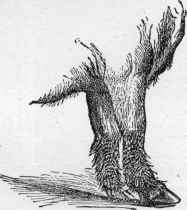
Fig. 119. Rat-tails of chronic Eczema.
growths called rattails may be produced, especially on
the legs. Even the hoofs may slough, so virulent is the
disease.
Remedy.—Comfortable quarters ½ give a laxative ; dress
parts with a lead and morphia (morphine) preparation.
Good food ; cleanliness.
276
THE DISEASES OF CATTLE.
ERYSIPELAS
Affects the whole thickness of the skin, sometimes in
volving the subcutaneous tissue also. Pain and febrile
symptoms are exhibited. It is caused by injuries, strong
external applications, burns, scalds, &c. The skin is very
red, which does not disappear on pressure. The inflam
mation may disappear or it may end in ulceration, mor
tification, or gangrene.
Remedy.—Draft : Tincture perchloride of iron, 1½
oz., spirit chloroform, ½ oz., water in proportion, every 4
hours ; or, tincture aconite (V. P.), 40 drops, chlorate
potassium, 3 drams, water in proportion, every 6 hours.
HERPES CIRCINATUS
Consists in vesicles similar to those of eczema, which
arrange themselves in a gradually widening ring or rings.

Fig. 120. Vesicles forming. Fig. 121. Appearance after Vesi
cles have burst or evaporated.
The vesicles burst, the fluid drying and forming scabs in
eight or nine days. The redness of the skin beneath
gradually dies away.
For remedy, see page 162.
SORE LIPS (IMPETIGO LABIALIS),
Occur in calves, lambs, goats, and pigs. Sometimes the
face and lips of older animals at grass are affected. In
calves the upper lip suffers especially, the eruptions ex-
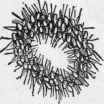
SKIN DISEASES. 277
tending to the membranes of the mouth and nostrils.
The disease may possibly be caused by the richness of
the milk or by acrid plants.
Change diet. Apply suitable ointment. A purge may
be useful.
NETTLE-RASH (URTICARIA),
Consists in numerous eruptions, averaging about two
and a half inches in diameter. There is great itching,
some increase of temperature, but little or no tenderness
or fever. The hair is shed in a few days, leaving bald
patches. The eruptions appear suddenly, and usually dis
appear in about twelve days. Cattle that have been badly
kept in the winter and have become rapidly plethoric are
most liable to the disease in summer.
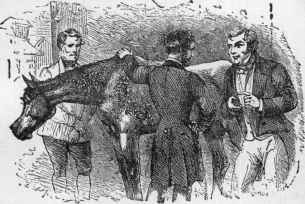
Fig. 122. Nettle-Rash in the horse, the same as in the ox.
Remedy.—Strong saline purge. Paint patches with
lotion of glycerine, carbonate of sodium, and laudanum.
Sulphur and bicarbonate of potassium in food. Cleanli
ness, comfort.
Draft : Bicarbonate potassium, ½ oz., bicarbonate sodi-
278
THE DISEASES OF CATTLE.
um, ½ oz., nitrate potassium, ½ oz., water in proportion,
twice daily.
PRURIGO
Is sometimes called ‘ spring-lice.’ It is especially com
mon in the spring. Pimples appear on the body and legs,
crusts form, which, with the hair, are shed. Coat stares.
Treat as for nettle-rash.
ELEPHANTIASIS
Is said to be “a blood disease, probably originating in
an animal poison, and manifesting its existence either by
the deposition of a peculiar albuminous substance in the
skin, mucous membrane, and other surface tissues of the
body, or by affecting chiefly the nervous centers and the
nerves. This double mode of manifestation of the disease
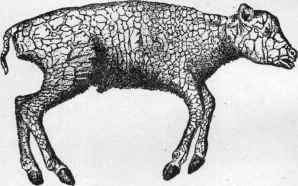
Fig. 123. Elephantiasis.
has caused its division into two kinds—tubercular and
anæsthetic” “Both forms are chronic in their course,
commencing insidiously, progressing slowly, and lasting
for years, sometimes terminating in spontaneous cure and
sometimes in death." (Erasmus Wilson.)
For further information and remedies, see page 164.
SKIN DISEASES.
279
ECTHYMA,
Which consists of large, prominent, well-defined, and
isolated pustules, is rare. The pustules burst, produce a
dark colored scab, which, when shed, leaves a brown stain.
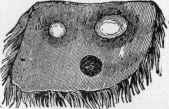
Fig. 124. Ecthyma.
The disease is liable to be mistaken for smallpox. Treat
as for nettle-rash.
PEMPHIGUS
Consists in watery bladders, which appear in all parts
of the body. In severe cases the bladders may contain
pus and blood. They differ in size. Some are as large
as a hen's egg. They usually appear and disappear rap
idly, sometimes in a few hours. The chronic form, how
ever, may last for months. The bladders burst, or possi
bly dry up without bursting. Scabs form, which, when
shed, reveal a red spot.
Remedy.—Open bladders. Gentle purge ; then alka
lies. Apply astringent powders, such as starch or the
oxide of zinc ointment.
Boils (Furunculus) are caused by intense localized
inflammation, involving the subcutaneous areolar tissue
and leading to death of a part of the structure, which
is expelled as the ‘core.' Poultices and fomentations, as
in man. Ordinary boils may be left to nature.
280
THE DISEASES OF CATTLE.
Carbuncles differ from boils mainly in the large
amount of tissue which dies. Remove dead tissue with
knife. Antiseptic dressings. Tonics if necessary. For
lists of antiseptics and tonics, see pages 31 and 37 respec
tively.
Scurf (Pityriasis), is most frequent in young animals.
Mild sedative ointment. Change diet.
Nævus means a slight tumor composed of blood ves
sels. There is usually some enlargement of the superfi
cial layer of the skin.
Warts or Angle Beries may be removed with the
knife, ligature, or écraseur. Stop bleeding, if necessary,
with hot iron. Some warts are as large as apples.
Baldness (Alopecia), may sometimes be cured by mild
but repeated stimulation with tincture of cantharides.
Dropsy (Anasarca), of the subcutaneous tissue of the
lower part of the body is not very rare. Careful nurs
ing ; hand rubbing ; small doses of digitalis.
Emphysema (Inflation), is caused by the escape of
gases, resulting from decomposition, into the subcutane
ous areolar tissue, as may be seen in some cases of black
quarter. Careful feeding. Give stimulant. Rub surface.
Make incisions through skin if necessary. Usually there
is marked debility.
\
But first, if you want to come back to this web site again, just add it to your bookmarks or favorites now! Then you'll find it easy!
Also, please consider sharing our helpful website with your online friends.
BELOW ARE OUR OTHER HEALTH WEB SITES: |
Copyright © 2000-present Donald Urquhart. All Rights Reserved. All universal rights reserved. Designated trademarks and brands are the property of their respective owners. Use of this Web site constitutes acceptance of our legal disclaimer. | Contact Us | Privacy Policy | About Us |